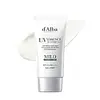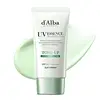What's inside
What's inside
 Key Ingredients
Key Ingredients

 Benefits
Benefits

 Concerns
Concerns

No concerns
 Ingredients Side-by-side
Ingredients Side-by-side

Water
Skin ConditioningCyclohexasiloxane
EmollientIsododecane
EmollientButyloctyl Salicylate
Skin Conditioning2,3-Butanediol
HumectantPropylheptyl Caprylate
EmollientCaprylyl Methicone
Skin ConditioningPolyglyceryl-3 Polydimethylsiloxyethyl Dimethicone
Skin ConditioningMagnesium Sulfate
Lauryl Polyglyceryl-3 Polydimethylsiloxyethyl Dimethicone
Skin ConditioningDisteardimonium Hectorite
StabilisingMethyl Methacrylate Crosspolymer
Polymethylsilsesquioxane
Triethoxycaprylylsilane
1,2-Hexanediol
Skin ConditioningPolyglyceryl-2 Dipolyhydroxystearate
Skin ConditioningAlumina
AbrasiveCitrus Aurantium Dulcis Oil
MaskingHippophae Rhamnoides Fruit Oil
Skin ProtectingPropylene Carbonate
SolventGlyceryl Caprylate
EmollientCaprylyl Glycol
EmollientCitrus Nobilis Peel Oil
MaskingEthylhexylglycerin
Skin ConditioningSodium Hyaluronate
HumectantLitsea Cubeba Fruit Oil
MaskingTocopherol
AntioxidantHydrolyzed Sodium Hyaluronate
Skin ConditioningCeramide NP
Skin ConditioningPanthenol
Skin ConditioningMelaleuca Alternifolia Leaf Water
AntimicrobialButylene Glycol
HumectantCentella Asiatica Leaf Extract
Skin ConditioningCentella Asiatica Extract
CleansingWater, Cyclohexasiloxane, Isododecane, Butyloctyl Salicylate, 2,3-Butanediol, Propylheptyl Caprylate, Caprylyl Methicone, Polyglyceryl-3 Polydimethylsiloxyethyl Dimethicone, Magnesium Sulfate, Lauryl Polyglyceryl-3 Polydimethylsiloxyethyl Dimethicone, Disteardimonium Hectorite, Methyl Methacrylate Crosspolymer, Polymethylsilsesquioxane, Triethoxycaprylylsilane, 1,2-Hexanediol, Polyglyceryl-2 Dipolyhydroxystearate, Alumina, Citrus Aurantium Dulcis Oil, Hippophae Rhamnoides Fruit Oil, Propylene Carbonate, Glyceryl Caprylate, Caprylyl Glycol, Citrus Nobilis Peel Oil, Ethylhexylglycerin, Sodium Hyaluronate, Litsea Cubeba Fruit Oil, Tocopherol, Hydrolyzed Sodium Hyaluronate, Ceramide NP, Panthenol, Melaleuca Alternifolia Leaf Water, Butylene Glycol, Centella Asiatica Leaf Extract, Centella Asiatica Extract
Water
Skin ConditioningDibutyl Adipate
EmollientDicaprylyl Carbonate
EmollientPropanediol
SolventButyloctyl Salicylate
Skin ConditioningTitanium Dioxide
Cosmetic Colorant2,3-Butanediol
HumectantDiethylamino Hydroxybenzoyl Hexyl Benzoate
UV FilterPolysilicone-15
UV FilterNiacinamide
SmoothingEthylhexyl Triazone
UV Absorber1,2-Hexanediol
Skin ConditioningPentylene Glycol
Skin ConditioningCentella Asiatica Extract
CleansingTuber Magnatum Extract
Skin ConditioningStellaria Media Extract
Skin ConditioningMorus Alba Root Extract
BleachingCitrus Aurantium Bergamia Fruit Oil
MaskingSimmondsia Chinensis Seed Oil
EmollientMelaleuca Alternifolia Leaf Water
AntimicrobialAbies Sibirica Oil
MaskingLavandula Hybrida Oil
EmollientCitrus Aurantifolia Oil
CleansingJuniperus Mexicana Oil
MaskingPelargonium Graveolens Flower Oil
MaskingPogostemon Cablin Leaf Oil
MaskingLitsea Cubeba Fruit Oil
MaskingMentha Viridis Leaf Oil
AstringentHydrogenated Lecithin
EmulsifyingSodium Hyaluronate
HumectantCoco-Caprylate/Caprate
EmollientVp/Eicosene Copolymer
Methylpropanediol
SolventPolyglyceryl-2 Caprate
EmulsifyingGlycerin
HumectantSucrose Stearate
EmollientAmmonium Acryloyldimethyltaurate/Vp Copolymer
Polyacrylate Crosspolymer-6
Emulsion StabilisingAlumina
AbrasiveHydroxypropyl Methylcellulose Stearoxy Ether
Stearic Acid
CleansingEthylhexylglycerin
Skin ConditioningPolyhydroxystearic Acid
EmulsifyingInulin Lauryl Carbamate
Emulsion StabilisingGlyceryl Caprylate
EmollientXanthan Gum
EmulsifyingAdenosine
Skin ConditioningTriethoxycaprylylsilane
Squalane
EmollientPolyether-1
Propylheptyl Caprylate
EmollientTocopherol
AntioxidantButylene Glycol
HumectantPanthenol
Skin ConditioningBiosaccharide Gum-1
HumectantLactobacillus Ferment
Skin ConditioningDimethylsilanol Hyaluronate
HumectantHydrolyzed Sodium Hyaluronate
Skin ConditioningHydrolyzed Hyaluronic Acid
HumectantPotassium Hyaluronate
Skin ConditioningHyaluronic Acid
HumectantSodium Hyaluronate Crosspolymer
HumectantHydroxypropyltrimonium Hyaluronate
Sodium Hyaluronate Dimethylsilanol
HumectantSodium Acetylated Hyaluronate
HumectantMadecassoside
AntioxidantAsiaticoside
AntioxidantAsiatic Acid
Skin ConditioningCaprylic/Capric Triglyceride
MaskingSucrose Distearate
EmollientHydroxypropyl Cyclodextrin
MaskingRetinal
Skin ConditioningChromium Oxide Greens
Limonene
PerfumingLinalool
PerfumingCitral
PerfumingWater, Dibutyl Adipate, Dicaprylyl Carbonate, Propanediol, Butyloctyl Salicylate, Titanium Dioxide, 2,3-Butanediol, Diethylamino Hydroxybenzoyl Hexyl Benzoate, Polysilicone-15, Niacinamide, Ethylhexyl Triazone, 1,2-Hexanediol, Pentylene Glycol, Centella Asiatica Extract, Tuber Magnatum Extract, Stellaria Media Extract, Morus Alba Root Extract, Citrus Aurantium Bergamia Fruit Oil, Simmondsia Chinensis Seed Oil, Melaleuca Alternifolia Leaf Water, Abies Sibirica Oil, Lavandula Hybrida Oil, Citrus Aurantifolia Oil, Juniperus Mexicana Oil, Pelargonium Graveolens Flower Oil, Pogostemon Cablin Leaf Oil, Litsea Cubeba Fruit Oil, Mentha Viridis Leaf Oil, Hydrogenated Lecithin, Sodium Hyaluronate, Coco-Caprylate/Caprate, Vp/Eicosene Copolymer, Methylpropanediol, Polyglyceryl-2 Caprate, Glycerin, Sucrose Stearate, Ammonium Acryloyldimethyltaurate/Vp Copolymer, Polyacrylate Crosspolymer-6, Alumina, Hydroxypropyl Methylcellulose Stearoxy Ether, Stearic Acid, Ethylhexylglycerin, Polyhydroxystearic Acid, Inulin Lauryl Carbamate, Glyceryl Caprylate, Xanthan Gum, Adenosine, Triethoxycaprylylsilane, Squalane, Polyether-1, Propylheptyl Caprylate, Tocopherol, Butylene Glycol, Panthenol, Biosaccharide Gum-1, Lactobacillus Ferment, Dimethylsilanol Hyaluronate, Hydrolyzed Sodium Hyaluronate, Hydrolyzed Hyaluronic Acid, Potassium Hyaluronate, Hyaluronic Acid, Sodium Hyaluronate Crosspolymer, Hydroxypropyltrimonium Hyaluronate, Sodium Hyaluronate Dimethylsilanol, Sodium Acetylated Hyaluronate, Madecassoside, Asiaticoside, Asiatic Acid, Caprylic/Capric Triglyceride, Sucrose Distearate, Hydroxypropyl Cyclodextrin, Retinal, Chromium Oxide Greens, Limonene, Linalool, Citral
Ingredients Explained
These ingredients are found in both products.
Ingredients higher up in an ingredient list are typically present in a larger amount.
1,2-Hexanediol is a synthetic liquid and another multi-functional powerhouse.
It is a:
- Humectant, drawing moisture into the skin
- Emollient, helping to soften skin
- Solvent, dispersing and stabilizing formulas
- Preservative booster, enhancing the antimicrobial activity of other preservatives
2,3-Butanediol is a naturally occurring humectant and solvent. It's created from fermentation and can be found in foods like cocoa butter and sweet corn.
This ingredient attracts and holds onto moisture to boost hydration in skin. According to a manufacturer, this ingredient improves the spreadability of ingredients like vitamin C.
Alumina is another name for the compound aluminum oxide. It is used as a thickener, absorbent, and abrasive.
As an absorbent, alumina can give a mattifying effect. It is used in mineral sunscreens to help coat nano-sized filters, such as titanium dioxide. By increasing the size of the UV filters, these ingredients stay on the skin for a longer time. By coating small sized ingredients, alumina helps thicken a product.
Alumina may be used as an abrasive, or exfoliant.
Alumina is naturally occurring in the mineral corundum. Certain varieties of corundum create rubies and sapphires. Corundum is also the crystalline form of alumina.
Learn more about AluminaButylene Glycol (or BG) is used within cosmetic products for a few different reasons:
Overall, Butylene Glycol is a safe and well-rounded ingredient that works well with other ingredients.
Though this ingredient works well with most skin types, some people with sensitive skin may experience a reaction such as allergic rashes, closed comedones, or itchiness.
Learn more about Butylene GlycolButyloctyl Salicylate is a chemical UV filter structurally similar to octisalate. It is a photostabilizer, SPF booster, emollient and solvent. This ingredient helps evenly spread out ingredients.
According to a manufacturer, it is suitable for pairing with micro Titanium Dioxide, Zinc Oxide, and pigments.
Photostabilizers help stabilize UV-filters and prevents them from degrading quickly.
Learn more about Butyloctyl SalicylateCentella Asiatica Extract (Centella) is derived from an herb native to Southeast Asia. It is famous for its anti-inflammatory and soothing properties.
Centella is rich in antioxidants and amino acids, such as Madecassic Acid and Asiaticoside.
Studies show the compounds in centella help with:
The combination of all these properties makes centella effective at soothing, hydrating, and protecting the skin.
Other great components of centella include Vitamin A, vitamin C, several B vitamins, and Asiatic Acid.
Fun fact: Centella has been used as a medicine and in food for many centuries. As a medicine, it is used to treat burns, scratches, and wounds.
Learn more about Centella Asiatica ExtractEthylhexylglycerin (we can't pronounce this either) is commonly used as a preservative and skin softener. It is derived from glyceryl.
You might see Ethylhexylglycerin often paired with other preservatives such as phenoxyethanol. Ethylhexylglycerin has been found to increase the effectiveness of these other preservatives.
Glyceryl Caprylate comes from glycerin and caprylic acid, a fatty acid from coconut. It has emollient and emulsifier properties.
As an emollient, it helps hydrate your skin. Emollients work by creating a barrier on your skin to trap moisture in, helping to keep your skin soft and smooth.
On the other hand, emulsifiers prevent ingredients (such as oil and water) from separating.
Learn more about Glyceryl CaprylateThis ingredient is created by putting sodium hyaluronate through hydrolysis.
You might know this as 'mini' or 'ultra low-molecular weight' hyaluronic acid. The small molecule size means it is able to travel deeper in the skin.
According to studies, low molecular-weight hyaluronic acid can:
One study from 2011 found ultra-low weight HA to show pro-inflammatory properties. Another study from 2022 found it to downregulate UV-B induced inflammation.
Hydrolysis is a process of changing a molecule using water or enzymes.
This ingredient is water-soluble.
Learn more about Hydrolyzed Sodium HyaluronateLitsea Cubeba Fruit Oil is a fragrance and is an oil.
This ingredient is created by distilling parts of the tea tree plant. The bark and leaves of the tea tree plant are rich in Terpinen, an antioxidant, antibacterial, and anti-inflammatory ingredient.
Tea tree may cause sensitivity and irritation for some people due to its linalool and limonene content.
Learn more about tea tree benefits here.
Learn more about Melaleuca Alternifolia Leaf WaterPanthenol is a common ingredient that helps hydrate and soothe the skin. It is found naturally in our skin and hair.
There are two forms of panthenol: D and L.
D-panthenol is also known as dexpanthenol. Most cosmetics use dexpanthenol or a mixture of D and L-panthenol.
Panthenol is famous due to its ability to go deeper into the skin's layers. Using this ingredient has numerous pros (and no cons):
Like hyaluronic acid, panthenol is a humectant. Humectants are able to bind and hold large amounts of water to keep skin hydrated.
This ingredient works well for wound healing. It works by increasing tissue in the wound and helps close open wounds.
Once oxidized, panthenol converts to pantothenic acid. Panthothenic acid is found in all living cells.
This ingredient is also referred to as pro-vitamin B5.
Learn more about PanthenolWe don't have a description for Propylheptyl Caprylate yet.
Sodium Hyaluronate is hyaluronic acid's salt form. It is commonly derived from the sodium salt of hyaluronic acid.
Like hyaluronic acid, it is great at holding water and acts as a humectant. This makes it a great skin hydrating ingredient.
Sodium Hyaluronate is naturally occurring in our bodies and is mostly found in eye fluid and joints.
These are some other common types of Hyaluronic Acid:
Learn more about Sodium HyaluronateTocopherol (also known as Vitamin E) is a common antioxidant used to help protect the skin from free-radicals and strengthen the skin barrier. It's also fat soluble - this means our skin is great at absorbing it.
Vitamin E also helps keep your natural skin lipids healthy. Your lipid skin barrier naturally consists of lipids, ceramides, and fatty acids. Vitamin E offers extra protection for your skin’s lipid barrier, keeping your skin healthy and nourished.
Another benefit is a bit of UV protection. Vitamin E helps reduce the damage caused by UVB rays. (It should not replace your sunscreen). Combining it with Vitamin C can decrease sunburned cells and hyperpigmentation after UV exposure.
You might have noticed Vitamin E + C often paired together. This is because it is great at stabilizing Vitamin C. Using the two together helps increase the effectiveness of both ingredients.
There are often claims that Vitamin E can reduce/prevent scarring, but these claims haven't been confirmed by scientific research.
Learn more about TocopherolTriethoxycaprylylsilane is a silicone used to bind and stabilize ingredients.
As an emulsifier, it helps prevent ingredients from separating. This can help elongate the shelf life of products.
Triethoxycaprylylsilane is often used to coat mineral sunscreens ingredients to help give a better feel. It also helps reduce oxidative stress in sunscreens.
Learn more about TriethoxycaprylylsilaneWater. It's the most common cosmetic ingredient of all. You'll usually see it at the top of ingredient lists, meaning that it makes up the largest part of the product.
So why is it so popular? Water most often acts as a solvent - this means that it helps dissolve other ingredients into the formulation.
You'll also recognize water as that liquid we all need to stay alive. If you see this, drink a glass of water. Stay hydrated!
Learn more about Water